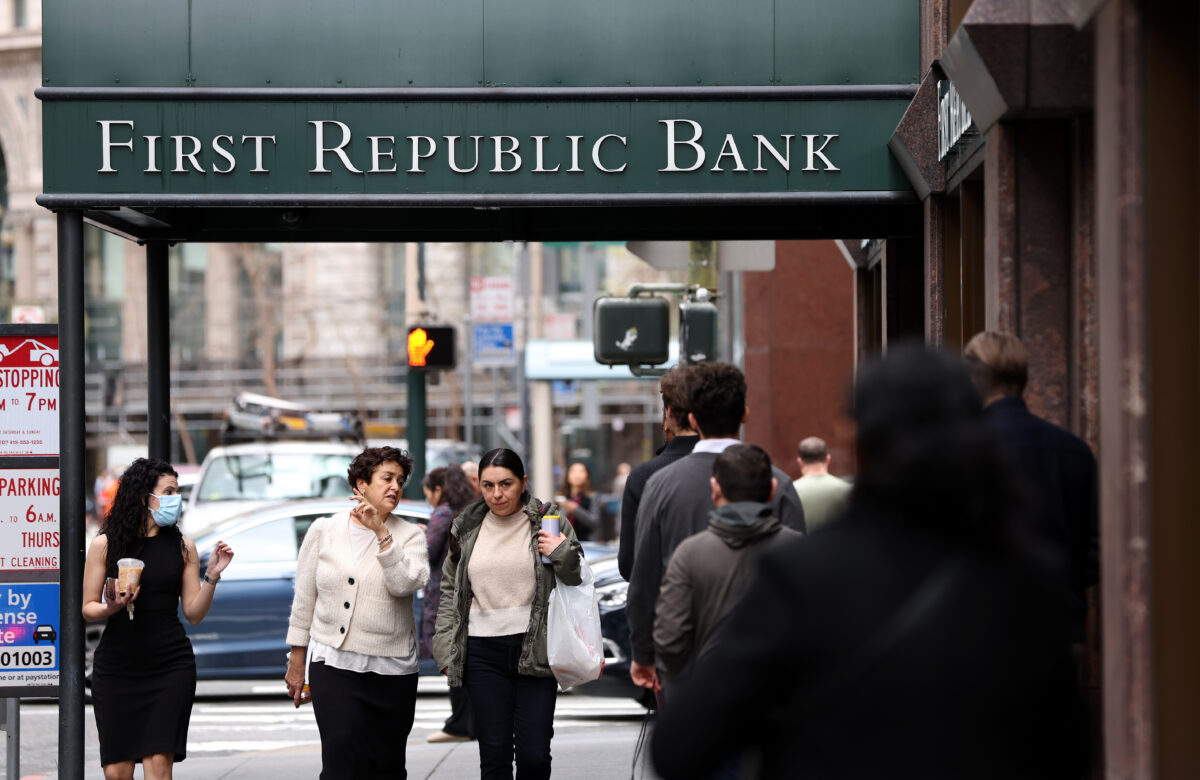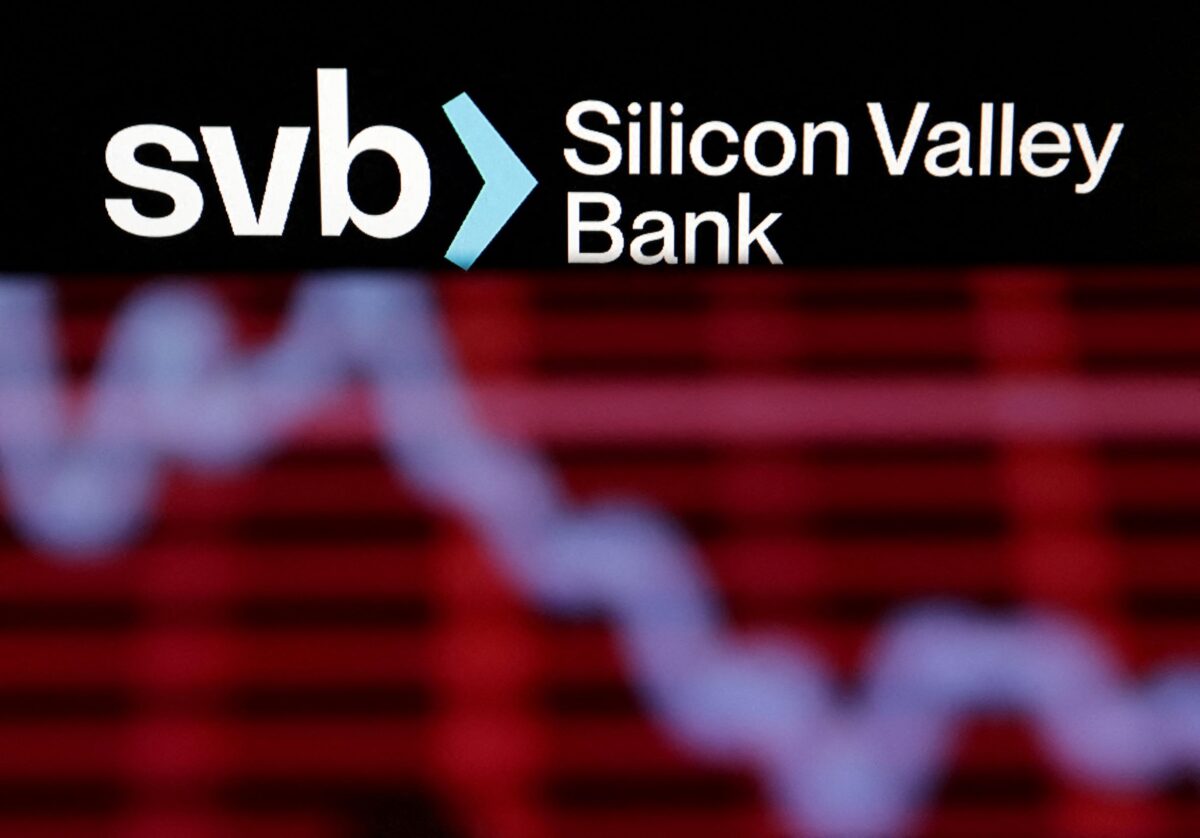
A pedestrian walks by a First Republic Bank in San Francisco, California, on April 26, 2023. (Justin Sullivan/Getty Images)
First Republic Bank has been seized by the Federal Deposit Insurance Corp. (FDIC), which announced on the morning of May 1 that the beleaguered bank is being bought by JPMorgan Chase.
California financial regulators on May 1 ordered First Republic Bank closed, with the FDIC appointed as receiver.
“To protect depositors, the FDIC is entering into a purchase and assumption agreement with JPMorgan Chase Bank, National Association, Columbus, Ohio, to assume all of the deposits and substantially all of the assets of First Republic Bank,” the FDIC stated on May 1.
The purchase and assumption agreement will see the FDIC contribute an estimated $13 billion from its deposit insurance fund to sweeten the deal, which was hammered out late April 30 and early May 1 after several banks submitted last minute bids.
The Epoch Times hasn’t been able to confirm other participants in the bidding, but the FDIC stated that JPMorgan’s offer—which includes the assumption of all customer deposits and substantially all of its assets—fits the bill.
“The resolution of First Republic Bank involved a highly competitive bidding process and resulted in a transaction consistent with the least-cost requirements of the Federal Deposit Insurance Act,” the FDIC stated.
This refers to the legal requirement for the FDIC to pick a form of “resolution”—or orderly liquidation of a failing bank—that results in the lowest possible cost to its deposit insurance fund and, indirectly, to customers of healthy banks that will eventually be encumbered by the cost of topping up the fund via a special assessment (or insurance premium) on banks.
The FDIC is also entering into a loss-share transaction with JPMorgan Chase on real estate loans purchased from First Republic, an arrangement meant to both minimize disruptions for loan customers and maximize recoveries.
“The FDIC as receiver and JPMorgan Chase Bank, National Association, will share in the losses and potential recoveries on the loans covered by the loss-share agreement,” the FDIC stated.
First Republic Bank had approximately $229.1 billion in total assets and $103.9 billion in total deposits as of April 13.
Under the terms of the takeover, depositors of First Republic will automatically become depositors of JPMorgan Chase and will continue to have full access to their deposits.
On May 1, First Republic Bank’s 84 offices in eight states will reopen as branches of JPMorgan Chase, which will operate normally during regular business hours.
The transaction makes JPMorgan Chase—already the nation’s biggest bank—even larger.
The announcement of the deal caps weeks of speculation about the fate of First Republic, which was tossed a lifeline recently in the form of a $30 billion injection of uninsured deposits by five of the nation’s biggest banks, including JPMorgan.
First Republic was, by July 2020, the 14th biggest bank in the United States, and at the end of last year, it employed more than 7,200 people.
The San Francisco-based lender was, like other regional lenders, squeezed by the Federal Reserve’s rapid rate hikes in a bid to quash soaring inflation. Rising rates made the bank’s portfolio of bonds drop in value, and the March collapse of Silicon Valley Bank (SVB) sparked what First Republic executives said was an “unprecedented” outflow of deposits, sparking a steep selloff of its shares.

‘Unprecedented Deposit Outflows’
An earnings report (pdf) released by First Republic on April 24 revealed it had experienced an “unprecedented” run on deposits following the collapse of SVB and Signature Bank.
“With the closure of several banks in March, we experienced unprecedented deposit outflows,” Neal Holland, First Republic’s chief financial officer, said in the earnings report.
On March 9, a day before SVB failed, First Republic’s deposits stood at $173.5 billion, down 1.7 percent from year-end 2022.
But on March 10, as SVB’s collapse grabbed headlines, First Republic began experiencing an unprecedented run on its deposits that saw $101 billion in savings flee the bank through April 21.
Word of the deposit exodus sent First Republic Bank’s stock to record lows.
In the run-up to the FDIC’s April 29 seizure of First Republic, there was speculation as to whether the bank would try to continue operating while taking steps to bolster its balance sheet.
That seemed to be the preferred course of action for First Republic CEO Michael Roffler, who said in the earnings report that deposits had stabilized and the bank remained “fully committed” to serving its customers.
“With the stabilization of our deposit base and the strength of our credit quality and capital position, we continue to take steps to strengthen our business,” he said.
At the same time, First Republic said in the earnings report that it was “pursuing strategic options,” which is Wall Street code for looking for a white knight to swoop in for a rescue.
Some analysts say that the failure of First Republic will put more pressure on an already battered financial sector.

‘Credit Shocks’ Coming?
The banking crisis is expected to cause “credit shocks,” which would drag down economic growth, according to Morgan Stanley.
“Disruption in the financial system will leave its mark on the real economy,” Morgan Stanley economists wrote in a recent note. “Our banking analysts see permanently higher funding costs for banks going forward, and the disruption to funding markets will likely lead to a tightening in credit conditions.”
The manufacturing, commercial real estate, and technology sectors are the most vulnerable to a pullback in bank lending, according to Goldman Sachs.
A reduction in lending will result in lower business investment in these industries, Jan Hatzius, chief economist of Goldman Sachs, wrote in a recent note.
“We also expect slowing job growth in the leisure and hospitality and other services industries, as diminished loan availability dissuades restaurant operators and other smaller businesses from hiring new workers and opening new establishments,” Hatzius said.
Although deposit outflows have stabilized in recent weeks after an initial surge in the wake of the SVB collapse, the banking sector isn’t yet out of the woods, experts say.
“The U.S. banking sector continues to have fundamental weaknesses that have been contained due to liquidity injections and short term loans,” Daniel Lacalle, chief economist at hedge fund Tressis, told The Epoch Times in an emailed statement.
“But the core problem remains: the profitable asset base has been destroyed by years of negative real rates.”
Negative real rates occur when nominal interest rates—those usually quoted by banks on loans and other financial products—are lower than the rate of inflation. Banks have a harder time turning profits when interest rates are low.
Before soaring prices forced the Fed to start hiking interest rates last March, there was a period of more than a decade during which the central bank expanded its balance sheet by buying government securities, driving interest rates to near zero, and flooding the economy with cheap money.
Analysts say many banks took added risks to increase investment returns during years of very low interest rates and some may have failed to hedge against the risk of rising interest rates.
“Deposit outflows have also forced banks to sell assets at a loss that they had intended to hold to maturity in order to generate the cash required to cover deposit withdrawals,” Ben Johnston, chief operating officer of Kapitus, a provider of financing for small and medium-sized businesses, told The Epoch Times in an emailed statement.
“These losses have reduced the equity value of the banks, weakening their ability to withstand future losses, and worrying their customer bases. While fear in the banking system has subsided, these risks have not gone away.”
Investor Warren Buffett predicted recently that “we’re not through with bank failures,” and JPMorgan CEO Jamie Dimon wrote in a letter to shareholders that even when the current crisis is behind us, “there will be repercussions from it for years to come.”
Liam Cosgrove and Emel Akan contributed to this report.
No comments:
Post a Comment